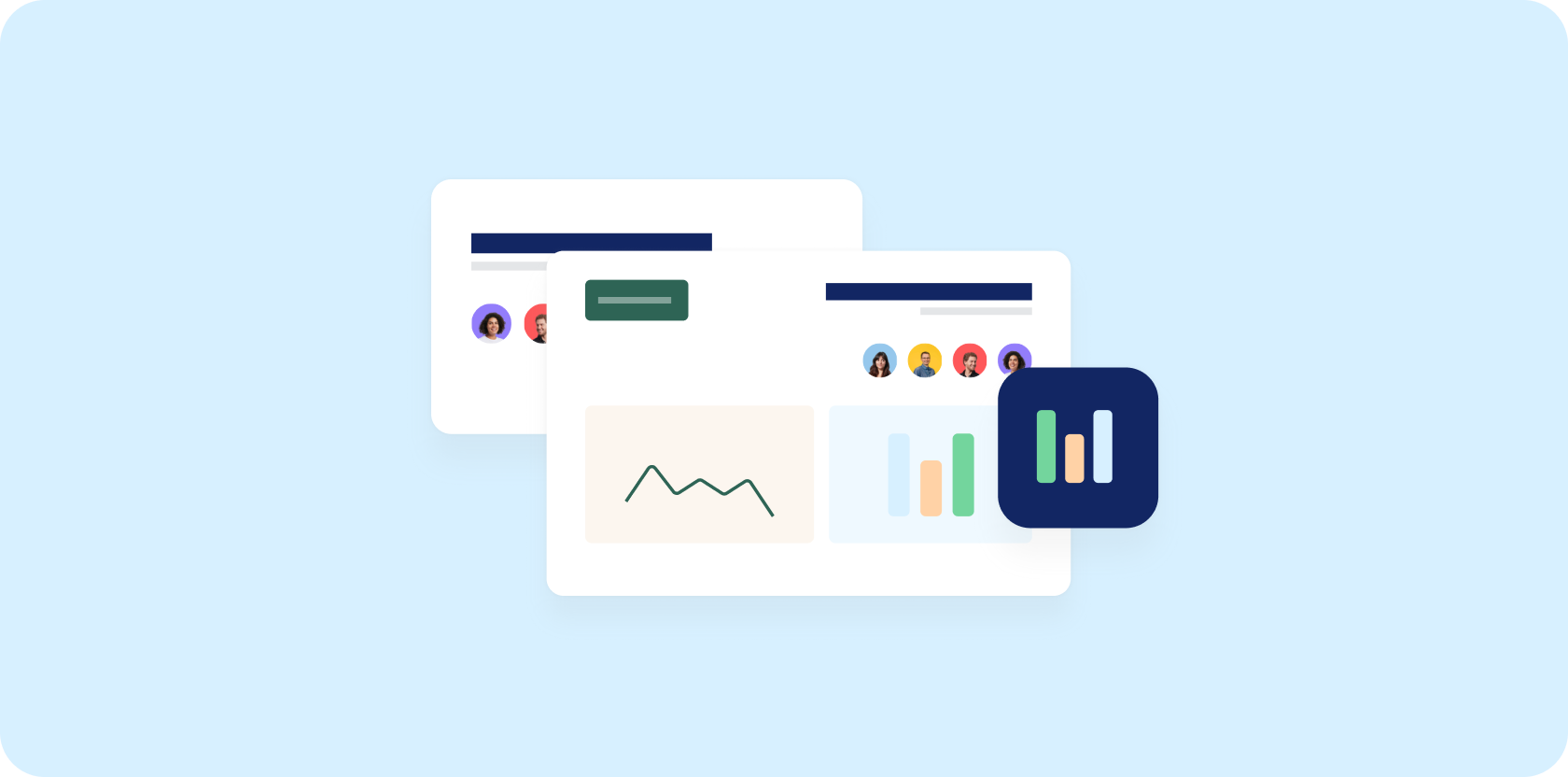
The Science Behind Wisnio - go beyond the resume
Focusing on surface-level candidate characteristics like skills and experience is easy to do. However, it is the underlying constructs of an individual's behaviour that determines a candidate's suitability for a role, and this data isn't on their resume.
Wisnio combines behavioural science and machine learning technology to give you objective insights into the deep-level characteristics and motivations of individuals.
Going beyond surface-level characteristics helps leaders better understand the candidates they interview and how well they will fit into the teams they'll be joining.
To learn more about the psychometric properties of the instruments used on the Wisnio platform, please read our whitepaper.
Fit theory and its role in defining team and role contexts

Fit is defined as the degree to which individual and organisational attributes are compatible, and is an important cornerstone of team analytics and candidate assessment¹. According to behavioural science research, fit takes two forms:
Supplementary fit
Individual and environmental attributes are similar in terms of values; applies on a person-team level
Complementary fit
Individual attributes are complemented by the organisational environment; company culture-fit
Supplementary fit focuses on values and personality
Research suggests that supplementary fit relates to attitudes towards peers, job attitudes and organisational citizenship². When focusing on supplementary fit and value matching in hiring, the results are:
- Stronger organisational culture
- Increased engagement
- Improved employee retention
Focus on person-team fit
Many enterprises have shifted focus towards company culture-fit approaches when hiring. However, understanding the fit between individual differences and organisation-level characteristics, especially in large enterprises, is near-impossible.
To top it off, there can be huge differences in internal culture between teams or departments in a single company.
There is also the issue of balancing diversity and fit to create teams that are aligned and well-rounded. Doing this requires a clear, objective understanding of individual and team preferences, as well as the right tools to make these insights clear and easy to grasp.
Success is where fit meets diversity
A team made up exclusively of creative people may lack pragmatism, and a team of methodical people may lack room for flexibility in idea generation. Depending on the team’s goals and objectives, a diverse group may do better than one with very similar traits and motivational preferences.
Understanding where diversity or fit is more important is an essential part of hiring, especially at an executive level. Behavioural insights and tools that visualise individual variability within a team can help hiring managers navigate the complexities of human preferences to make effective people decisions.
“A meta-analysis of 108 studies and more than 10,000 teams indicated that the creativity gains produced by higher team diversity are disrupted by the inherent social conflict and decision-making deficits that less homogeneous teams create. It would therefore make sense for organizations to increase diversity in teams that are focused on exploration or idea generation, and use more-homogeneous teams to curate and implement those ideas.”
Tomas Chamorro-Premuzic
Harvard Business Review
Does Diversity Actually Increase Creativity?
Define contexts with competency assessments
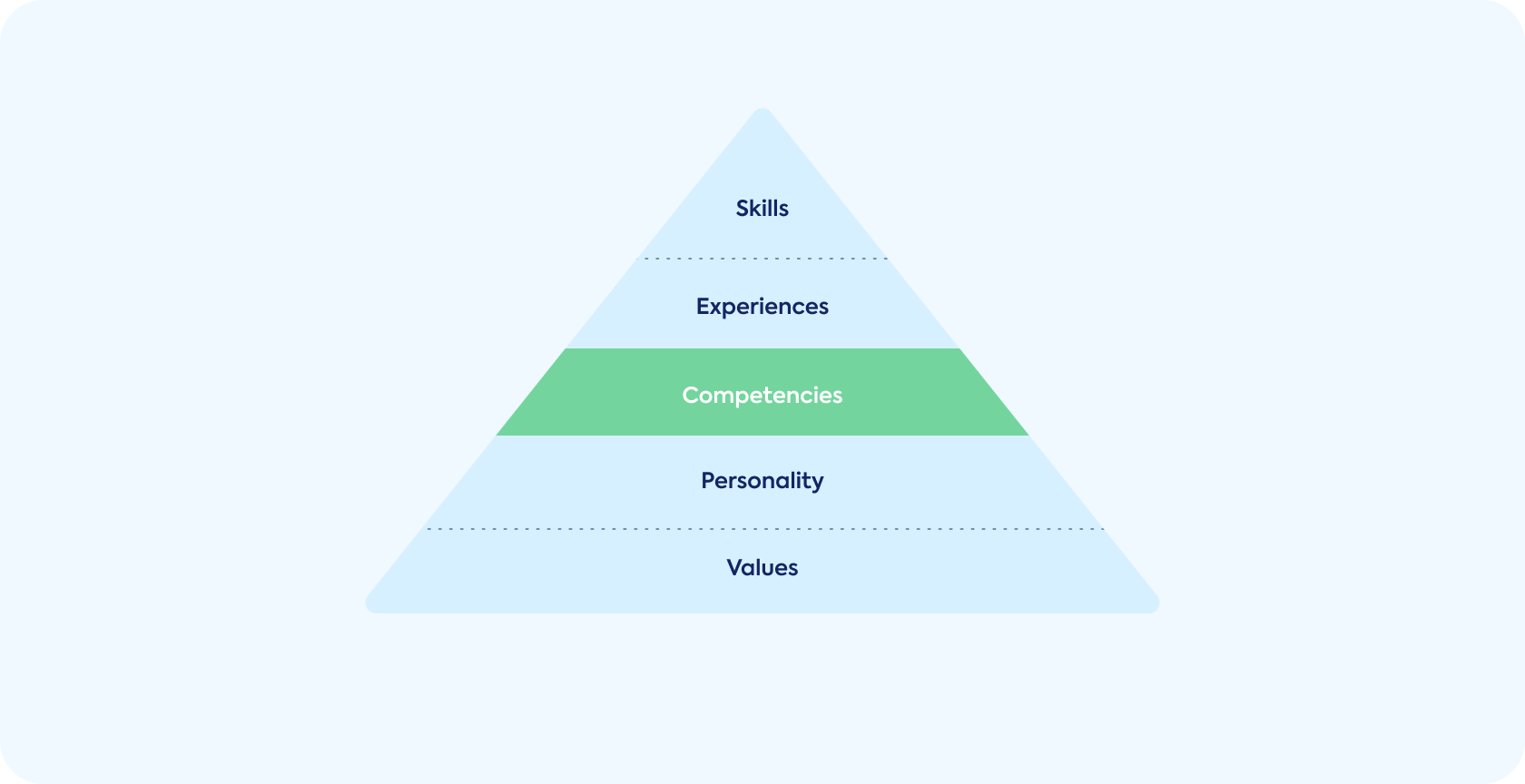
In 1993, Spencer and Spencer³ defined competencies as behaviours or thought processes that lead to superior job performance. Based on their groundbreaking research, Wisnio's Competency Survey asks users to rank 20 competencies. The insights are used to evaluate role suitability and team strengths.
Use competencies for hiring and team development
Competencies are the knowledge, skills, and abilities required to perform a job successfully. Usually, there are a few core competencies that differentiate top performers in a given industry and job function.
Systematically defining a job's critical competencies and evaluating candidates' competencies is the most objective way to shortlist candidates. Doing so brings clarity to the early stages of the hiring process, where the potential for ambiguity and bias is highest.
"If you are serious about hiring the best possible person for the job, this is what you should do. First, select a few traits that are prerequisites for success in this position [....] T you should feel that you can assess them reliably by asking a few factual questions. Next, make a list of those questions for each trait and think about how you will score it, say on a 1-5 scale."
Daniel Kahneman
Thinking, Fast and Slow
Nobel Prize Winner in Behavioural Economics
The science of personality and its role in hiring
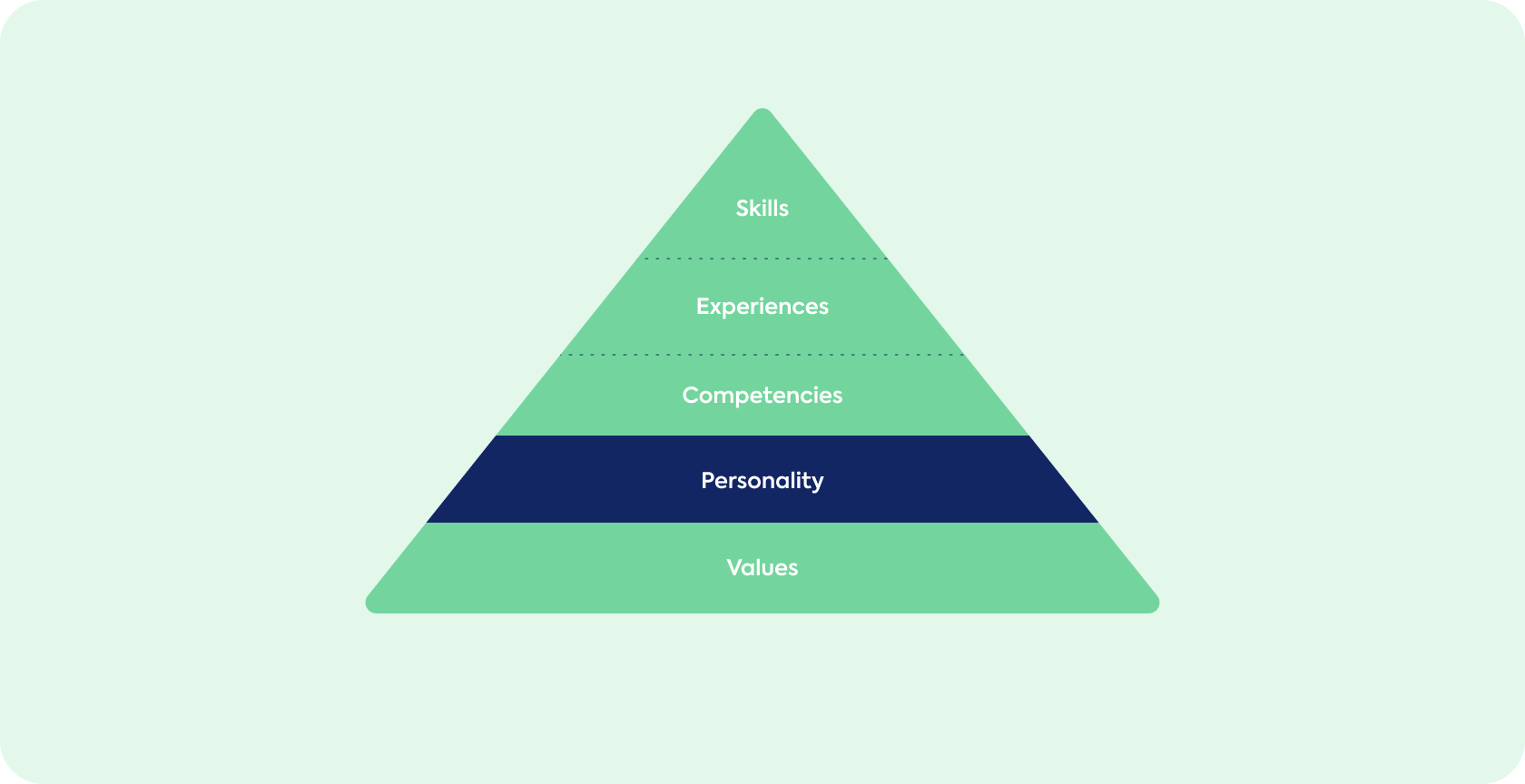
As the most robust and widely used personality frameworks in academic studies, the Big 5 Personality model was developed by Costa and McCrae in the 1970s⁴. Since then, their model has been used on millions of subjects and consistently demonstrates high construct validity and test-retest reliability across cultures, age, and gender.
Objective personality insights
Using personality frameworks, it is possible to get a clear, unbiased overview of an individual's traits and preferences without subjective judgements.
Understand team dynamics
Using objective methods to understand people results in accurate team-fit analyses. This, in turn, makes it easier to make lasting hiring decisions.
Wisnio uses the updated IPIP NEO framework, measuring four facets or dimensions for each factor. Each facet is measured by a total of four questions using a 7-point Likert scale.
The end result is a percentile value for each personality factor on a scale of 0 to 100, as well as detailed insights into individual strengths and personal preferences in an organizational setting.
As the name suggests, the Big 5 Personality model measures five personality factors:
Conscientiousness
Acting an organised and goal-oriented way
Agreeableness
Supporting and cooperating with others
Emotional range
Ability to remain calm and balanced
Extraversion
Seeking energy in the company of others
Openness
Receptivity to new ideas and experiences
The role of values in forming individual motivations
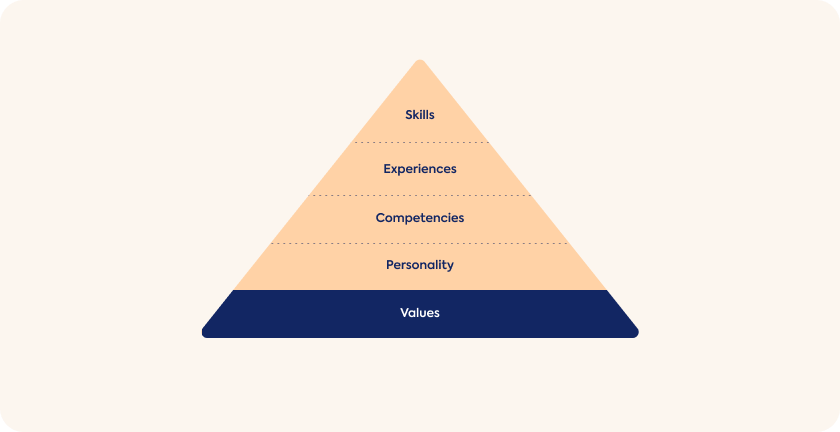
Unlike personality traits, described as enduring dispositions, values relate to goals and ideals that transcend specific actions and situations. Despite being universal, the degree to which individuals care about each value varies, forming a unique hierarchical value system.
Determine value-fit
According to research, value-fit has been found to strengthen organisational culture, improve engagement, and help with employee retention.
Motivate your teams
What drives individuals varies greatly, and understanding people's collective motivations can help you boost productivity and morale.
To help you identify individual value systems, Wisnio uses the refined values theory devised by Schwartz⁵. Schwartz defines values as the standards for judging behaviour both in ourselves and others and in a professional setting, they relate to the enduring goals and motivations of an individual. These value constructs have been supported across 80 countries since their publication in 1987.
Adapted from Schwartz's universal values model, Wisnio's values survey identifies core motivators and attitude-drivers, as well as the type of work environments individuals would thrive in.
Self vs. personal focus
Every value has a social or a person focus. Person-focused goals are concerned with individual outcomes, while social-focused goals are concerned with consequences for others.
Protecting vs. expanding the self
Values can also be related to protecting the self or expanding the self. Self-transcendence and openness to change values express self-expansive, growth orientations. They oppose conservation and power values, which involve self-protective, anxiety-control orientations.
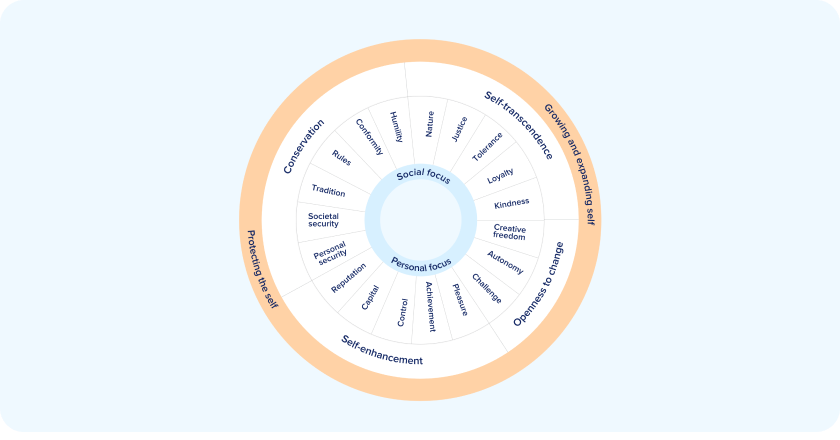
____________________
¹ van Vianen, A. E. (2018). Person–environment fit: A review of its basic tenets. Annual Review of Organizational Psychology and Organizational Behavior, 5, 75-101.
² Kristof‐Brown, A. L., Zimmerman, R. D., & Johnson, E. C. (2005). Consequences of individuals' fit at work: A meta analysis of person-job, person-organization, person-group, and person-supervisor fit. Personnel psychology, 58(2), 281-342.
³ Spencer, L.M., & Spencer, S.M. (1993). “Competence at Work: Model for superior Performance”, Human Resource Development Quarterly Vol. 5, Issue 4, pp 391-395.
⁴ McCrae, R. R., & John, O. P. (1992). An introduction to the five‐factor model and its applications. Journal of personality, 60(2), 175-215.
⁵ Schwartz, S. H., et al. (2012). Refining the Theory of Basic Individual Values. Journal of personality and social psychology.
Start your free trial today
The free trial gives you full access to the platform’s decisions tools, including the hiring, personal, and team analysis modules.
Start free trial- Actionable talent data
- Full platform functionality
- No credit card required